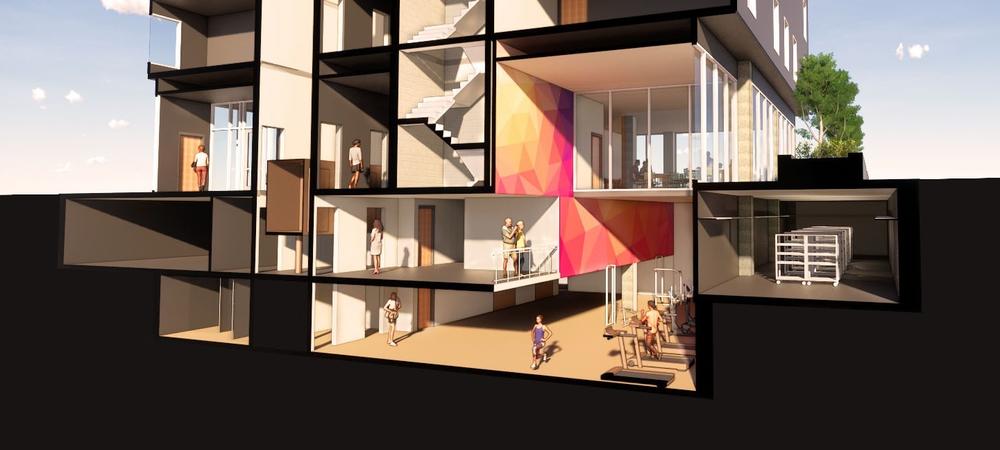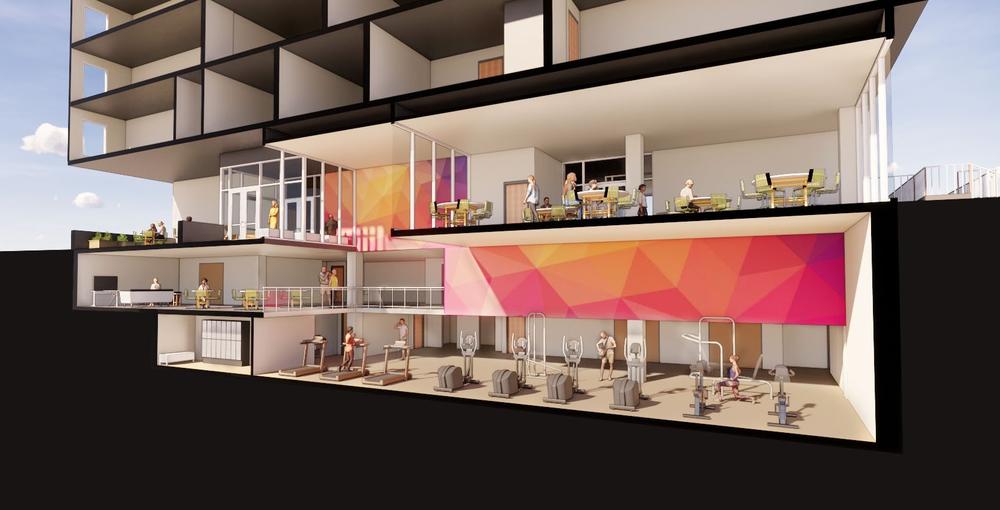
New research from CLPHA and Econsult Solutions shows that PHAs generate and induce multiple streams of economic activity benefitting those who reside in public housing, as well as local employers, governments, and industries. "The Economic Impact of Public Housing: Ongoing Investment with Wide Reaching Returns," highlights four key findings:
Public Housing is an Economic Driver
Housing authorities generate economic impacts that ripple through the community, city, and region. PHAs own and manage large property portfolios as well as directly support real estate markets through Housing Choice Vouchers and other housing assistance payments.
- Every $1 million PHAs spend on capital investments generates $1.89 million in economic activity and supports 11 full-time jobs
- From FY13-17, PHAs in Akron, Charlotte, Kansas City, Los Angeles, New York, and Oklahoma spent $4.5 billion on capital needs and generated an estimated $7.6 billion in economic activity, supporting 7,600 full-time jobs
Public Housing is Workforce Housing
While the majority of public housing residents are elderly and/or disabled, among work-able households, most are either working, subject to work requirements, or have worked recently.
Public Housing is a Long-Term Investment
The 1.1 million public housing units around the country are a significant investment by the federal government, with a replacement cost of $183 billion.
Public Housing is a Tax Revenue Generator
Public housing is a critical element of regional and local infrastructure due to its proximity to transportation, business centers, educational opportunities, other housing, and community centers, as well as its multiple economic intersections and influence on the economic growth of their cities.
- 6 PHAs generate $69 million in city tax revenue and $215 million in state tax revenue each year.
CLPHA’s Membership Spotlight features the outstanding work and achievements of our member public housing authorities - the nation’s largest and most innovative PHAs. Based on interviews with PHA executives, these brief profiles spotlight our members’ initiatives to strengthen their communities and improve life outcomes for their residents. The Membership Spotlight is published in the newsletter, on clpha.org, and on our social media platforms.
The Denver Housing Authority (DHA) knows that improving residents’ health outcomes is critical to improving other life outcomes. "DHA’s mission is not just to provide quality housing but also to provide empowerment and economic opportunity for residents,” said DHA Executive Director Ismael Guerrero in an interview. “Health is probably the most important thing that impacts our residents’ successes with school, work, job stability, and job security. Working with the health sector is the greatest way to impact resident health outcomes.”
That is why DHA and Denver Health, which operates Denver Health Medical Center in the heart of the city, are working together creatively in two new housing communities that will offer health-focused design features as well as on-site healthcare services and resources. DHA’s unique, cross-sector partnership combines their expertise in housing development, management, and resident services with Denver Health’s healthcare and medical knowledge.
When the master developer of a new community at the site of the former St. Anthony Hospital campus in Denver’s West Colfax neighborhood, adjacent to Denver’s Sloan’s Lake park, approached DHA to develop a mixed-use project, the housing authority quickly accepted the opportunity to build a significant amount of affordable housing in this growing, urban, transit-accessible neighborhood. “Building this property, named Vida, not only helped the master developer to fulfill their affordability commitment with the City,” said Guerrero, “but also provided the opportunity to bring back community healthcare services previously offered at the St. Anthony campus.”


Renderings of DHA's Vida community
DHA built Vida as a planned community for housing low-income seniors and individuals with disabilities as well as a ground-floor commercial condo that provides amenities and resources not only for Vida residents but also for the surrounding neighborhood. The commercial condo combines primary healthcare services with DHA’s Senior Activity Center, which made it a great candidate for attracting and leveraging New Markets Tax Credits (NMTC). DHA creatively stitched together a 9% Low-Income Housing Tax Credit (LIHTC), 4% LIHTC, and an NMTC allocation to create a complex funding structure, a process that Guerrero said was the most challenging aspect of the Project’s development.
Another challenge in Vida’s development process, said Guerrero, was figuring out how to build the property at a scale that would make a distinct impact on residents’ health. DHA worked with multiple local partners with synergies to offer a suite of healthcare services and resources on site, including Centura Health, Fresenius Medical Care, and Denver Health. DHA and Denver Health have a strong relationship, said Guerrero, having first worked together in 1993 on La Casa-Quigg Newton Family Health Center adjacent to DHA’s Quigg Newton Homes. Thus, asking Denver Health to join the Vida community was a natural fit. Denver Health will provide primary care and mental health services in an 8,000-square foot space on Vida’s ground floor in partnership with Centura Health. Fresenius Medical Care will operate a 10,000-square foot dialysis treatment center at the other corner of the property.
On November 1, Vida completed construction and DHA is now in the process of leasing to qualified residents, providing 176 new apartment units for low- and very low-income seniors and individuals with disabilities. Alongside Denver Health’s primary and mental healthcare services and Fresenius’ dialysis treatment facility, the community boasts high-quality design, energy efficient features, a rooftop community garden, and a Senior Activity and Wellness Center. Overall, the total project cost $65 million, an investment of which Guerrero, DHA, and all financing partners are very proud. “Sloan’s Lake is one of the fastest transitioning areas in Denver,” said Guerrero, “and for DHA to be able to create new affordable housing for seniors in this exciting new neighborhood was a great achievement.”
On DHA and Denver Health’s other recent collaboration, it was again a mutual interest that brought them together. Denver Health, which treats nearly one in three Denverites annually, cannot discharge a patient from the hospital if the patient has nowhere to go. Homeless and housing-unstable patients must stay in Denver Health beds even after they no longer need treatment, therefore occupying much-needed beds and incurring major expenses on the hospital.
However, Denver Health had a solution in mind – to convert a vacant office building it owns on the hospital campus into an apartment complex with over 100 units that would include single room occupancy (SRO) units to temporarily house housing-unstable discharged patients as they recover from treatment. Denver Health partnered with DHA to employ their affordable housing, real estate, and development expertise to transform the commercial building into housing units, and DHA jumped at the chance to create more affordable housing in the heart of Denver that also offers myriad health benefits to residents.
The hospital is selling DHA the 10-story, 74,000-square foot office building, which DHA is calling 655 Broadway, and granted the housing authority a long-term ground lease on the land for a nominal fee. The community will offer 14 SRO units for discharged patients referred by Denver Health to DHA where the discharged patients will be able to stay until they are ready to move out. A Denver Health case manager will help coordinate care for patients who move into these units. The rest of 655 Broadway’s units will permanently house low-income seniors and disabled individuals. “We saw this as a great opportunity to have seniors and disabled people living next to hospital services,” said Guerrero. “It’s so important for the residents to have the opportunity to live in these health-housing integrated communities with healthcare access right out their front door.”
DHA hopes to complete renovation on 655 Broadway by the end of 2021 and expects the project to cost $18 million. The housing authority will serve as the developer and is bringing in an architect to redesign both the interior and exterior of the building. Guerrero said that given the community’s medically oriented design needs, it’s helpful to have a healthcare partner that can offer guidance. In turn, Denver Health is benefitting from DHA’s knowledge of housing development and complex and mixed-use financing structures. The hospital and the housing authority’s complementary staff capacities allows each partner to do what they do best, Guerrero said.


Rendering of DHA's future 655 Broadway community
DHA’s goals for this project are to grow this partnership with Denver Health into a scalable, replicable model, to show that DHA can create long-term affordability in downtown Denver, and to make this collaboration with Denver Health worth the hospital’s investment. While it costs Denver Health $2,700 per night to house someone in a hospital bed, the hospital told Kaiser Health News that it will cost only about $10,000 to shelter a patient for a year in a traditional housing unit.
Over the course of their collaborations with Denver Health and other healthcare partners, DHA has learned about the health business and their business needs, while their health partners have learned about the affordable housing business, said Guerrero, and DHA and Denver Health’s understanding of each other has deepened over the years. This knowledge sharing results in more cost-effective and impactful health services. "[A]s the housing authority, we know housing, and as Denver Health, they know health and healthcare," Guerrero told Denver 7. "But, really our families and the people that we serve need both housing and healthcare, so by coming together in a common building, we can really provide all the services, all the attention, and the homes that these more unfortunate individuals need, when they are experiencing some kind of health crisis."
DHA’s commitment to resident health and partnership with Denver Health to achieve this goal tracks with CLPHA’s core thesis that housing stability contributes to improved life outcomes, and that cross-sector partnerships among the housing, health, and education sectors strengthen our collective ability to serve the needs of low-income individuals and families. CLPHA works to put these tenets into action through our Housing Is Initiative, which is helping to build a future where systems work together to improve life outcomes. CLPHA is proud to have DHA as a member and we look forward to hearing more about DHA’s work with Denver Health and other healthcare partners in the future.
On November 20, the Government Accountability Office (GAO) released a report updating the U.S. House Financial Services Subcommittee on Housing, Community Development and Insurance on the status of recommendations that the agency made to HUD in two previous reports regarding the Department’s inspections process and oversight of its lead paint regulations and lead grant programs.
In March 2019, the GAO released a report reviewing HUD’s physical inspections process. That report reviewed REAC’s methods for identifying property deficiencies, selecting and training inspectors, and their oversight of these processes. After reviewing REAC policies and interviewing HUD staff, inspectors, and industry groups, the GAO offered 14 recommendations to HUD to improve their inspections of multifamily and public housing properties. In June 2018, the GAO released a report reviewing HUD’s oversight of its lead paint regulations and lead grant programs, offering 9 recommendations to improve compliance and oversight.
In the new report, the GAO provides updates on the following recommendations made to HUD in the March 2019 report:
- Conduct a comprehensive review of the REAC inspection process. HUD reported to the GAO that they had recently completed a full review of the inspection process, but the GAO is still determining whether this review fully satisfies their recommendation.
- Incorporate sampling errors into their inspections process to improve score reliability. HUD has said that they will include sampling errors in the next version of its scoring software, which is to be implemented by September 2020.
- Make improvements to processes for selecting, training, and evaluating inspectors. HUD reported that a number of these recommendations were well in process. REAC recently began requiring a minimum of 8 hours of continuing education for quality assurance inspectors.
- Follow inspection schedule for multifamily properties and develop a system for tracking delays. REAC told the GAO that information technology improvements that are under development should improve on-time inspection tracking.
- Implement new quality control policies and procedures for its quality assurance inspectors. REAC told HUD that while the quality control group has developed new procedures to address the GAO’s concerns, they have yet to be implemented.
HUD has not taken any action on several other GAO recommendations, including its recommendations to: document its sampling methodology, design and implement an evaluation plan for staffing inspections in rural areas, and implement a plan for meeting management targets for quality assurance inspector reviews.
For recommendations on compliance with lead regulations and grant programs, the GAO provided updates on the following recommendations made to HUD in the June 2018 report:
- Improve monitoring of PHA compliance with lead paint regulations and develop procedures for enforcement actions in the case of noncompliance. HUD reported that they are requiring PHAs to submit paperwork documenting their compliance with lead paint regulations and the Department is currently drafting procedures for noncompliance.
- Standardize inspection protocols for lead paint between the public housing and voucher programs by requesting that Congress grant HUD the statutory authority to require more stringent lead inspection in the voucher program. HUD reported that they are working on proposed changes to the voucher program that would provide a different inspection process for lead that includes studying differences in costs and length of inspections associated with the proposed changes.
- Develop measures to track the effectiveness of lead paint regulations and make reporting requirements for lead paint regulations publicly available. HUD told the GAO that the Department is still determining the best way to meet this recommendation but that they will use data from the American Healthy Homes Survey to estimate the prevalence of lead paint in HUD-assisted housing. HUD also reported that it will be issuing a report to Congress on efforts to eliminate lead hazards in 2020.
CLPHA joined with industry colleagues NAHRO, PHADA, and the MTW Collaborative today to send a statement to House and Senate Committee leadership urging their support for the ACC contract language included in the Senate’s FY20 THUD Appropriations bill.
Because HUD’s proposed revisions to the ACC contain some provisions that are problematic and were not resolved during a joint industry meeting with PIH Assistant Secretary Hunter Kurtz and HUD staff, the four groups remain concerned that without the Senate appropriations language, HUD’s new ACC will not meet the standards set in the Housing Act of 1937 and the current ACC.
ACTION:
As members of the House and Senate Appropriations committee negotiate the final THUD appropriations bill, it is imperative that CLPHA members contact their Senators and Representatives and urge them to support the Senate’s language on the ACC.
If your Senators or Representatives are appropriators (see the list below) it is critical that CLPHA members contact them this week and ask them to support the Senate’s THUD Appropriations language on the ACC.
If you have questions about this action alert or the current status of the ACC, please contact CLPHA’s Legislative Director Gerard Holder at gholder@clpha.org.
Members of the Appropriations Committees
HOUSE APPROPRIATIONS COMMITTEE
|
MAJORITY |
State |
Dist. |
MINORITY |
State |
Dist. |
|
|
Nita M. Lowey, Chairwoman |
NY |
17 |
Kay Granger, Ranking Member |
TX |
12 |
|
|
Marcy Kaptur |
OH |
9 |
Harold Rogers |
KY |
5 |
|
|
Peter J. Visclosky |
IN |
1 |
Robert Aderholt |
AL |
4 |
|
|
Jose E. Serrano |
NY |
15 |
Michael K. Simpson |
ID |
2 |
|
|
Rosa L. DeLauro |
CT |
3 |
John Carter |
TX |
31 |
|
|
David E. Price, THUD Chair |
NC |
4 |
Ken Calvert |
CA |
42 |
|
|
Lucille Roybal-Allard |
CA |
40 |
Tom Cole |
OK |
4 |
|
|
Sanford D. Bishop, Jr. |
GA |
2 |
Mario Diaz-Balart, THUD Ranking |
FL |
25 |
|
|
Barbara Lee |
CA |
13 |
Tom Graves |
GA |
14 |
|
|
Betty McCollum |
MN |
4 |
Steve Womack |
AR |
3 |
|
|
Tim Ryan |
OH |
13 |
Jeff Fortenberry |
NE |
1 |
|
|
C.A. Dutch Ruppersberger |
MD |
2 |
Charles Fleischmann |
TN |
3 |
|
|
Debbie Wasserman Schultz |
FL |
23 |
Jaime Herrera Beutler |
WA |
3 |
|
|
Henry Cuellar |
TX |
28 |
David Joyce |
OH |
14 |
|
|
Chellie Pingree |
ME |
1 |
Andy Harris |
MD |
1 |
|
|
Mike Quigley, THUD Vice Chair |
IL |
5 |
Martha Roby |
AL |
2 |
|
|
Derek Kilmer |
WA |
6 |
Mark Amodei |
NV |
2 |
|
|
Matt Cartwright |
PA |
8 |
Chris Stewart |
UT |
2 |
|
|
Grace Meng |
NY |
6 |
Steven Palazzo |
MS |
4 |
|
|
Mark Pocan |
WI |
2 |
Dan Newhouse |
WA |
4 |
|
|
Katherine Clark |
MA |
5 |
John Moolenaar |
MI |
4 |
|
|
Pete Aguilar |
CA |
31 |
John Rutherford |
FL |
4 |
|
|
Lois Frankel |
FL |
21 |
Will Hurd |
TX |
23 |
|
|
Cheri Bustos |
IL |
17 |
||||
|
Bonnie Watson Coleman |
NJ |
12 |
||||
|
Brenda Lawrence |
MI |
14 |
||||
|
Norma Torres |
CA |
35 |
||||
|
Charlie Crist |
FL |
13 |
||||
|
Ann Kirkpatrick |
AZ |
2 |
||||
|
Ed Case |
HI |
1 |
SENATE APPROPRIATIONS COMMITTEE
|
MAJORITY |
State |
MINORITY |
State |
|
|
Richard C. Shelby |
AL |
Patrick J. Leahy, Vice Chair |
VT |
|
|
Mitch McConnell |
KY |
Patty Murray |
WA |
|
|
Lamar Alexander |
TN |
Dianne Feinstein |
CA |
|
|
Susan Collins, THUD Chair |
ME |
Richard J. Durbin |
IL |
|
|
Lisa Murkowski |
AK |
Jack Reed, Thud Ranking |
RI |
|
|
Lindsay Graham |
SC |
Jon Tester |
MT |
|
|
Roy Blunt |
MO |
Tom Udall |
NM |
|
|
Jerry Moran |
KS |
Jeanne Shaheen |
NH |
|
|
John Hoeven |
ND |
Jeff Merkley |
OR |
|
|
John Boozman |
AR |
Chris Coons |
DE |
|
|
Shelley Moore Capito |
WV |
Brian Schatz |
HI |
|
|
John Kennedy |
LA |
Tammy Baldwin |
WI |
|
|
Cindy Hyde-Smith |
MI |
Christopher Murphy |
CT |
|
|
Steve Daines |
MT |
Joe Manchin |
WV |
|
|
Marco Rubio |
FL |
Chris Van Hollen |
MD |
|
|
James Lankford |
OK |
|||